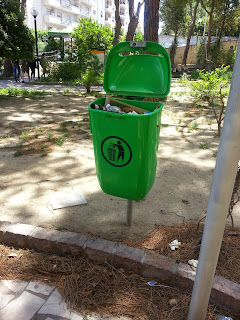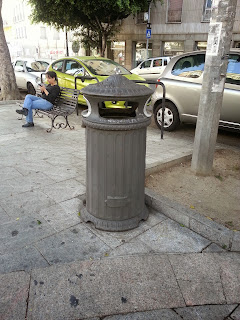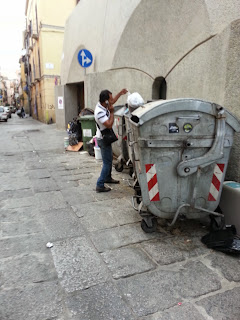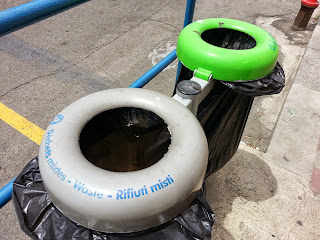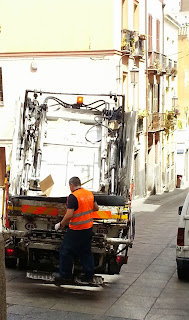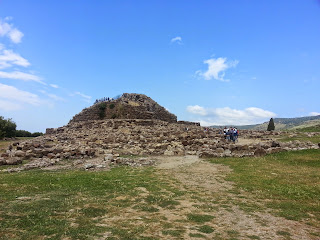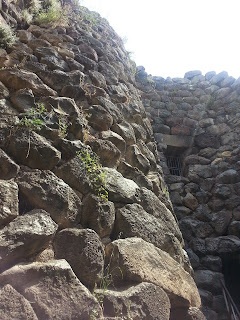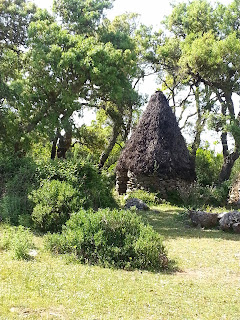Today, we went on our first technical visit to see three different facilities that serve the people of Cagliari and surrounding areas. These facilities are located about 20-30 minutes outside of the city and in a more industrial district. For those unfamiliar with my trip, I am currently taking a class involving resource recovery and waste management and different policies involved abroad.
 |
| High-quality paper from industry to be recycled |
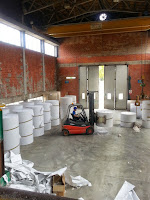 |
| Finished paper product ready to be sold |
 |
| Paper-water pulp mixture |
The first place that we went to was a paper and cardboard recycling facility whose end product was the corrugated part of corrugated cardboard, white paper, and other paper products such as paper bags. Most of the product that the facility produces, about 98-99%, is the corrugated cardboard/brown paper product because it is created from the societal paper waste which can be a mix of many different types of paper products. The other 1-2% of the recycling facility's production is high-quality white paper. This percentage is so low because high-quality paper must be used in order to make high-quality paper. It cannot be produced from the mix of paper products that is found in the societal waste because of the nature of the paper. Therefore, it is produced less and must be made from paper waste from industry. Today when we visited, they were creating the high-quality white paper. It is formed by going through a process that starts by mixing the paper with water creating a type of paper-water soup mixture called pulp. This is then run through a series of different sieves to make sure that all contaminants, for example binder pieces or staples, are removed from the product. Once all contaminants are removed, the water starts to be removed from the mixture slowly using gravity, pressure, and heat. The final paper is then collected and cut even on all sides and re-rolled onto cardboard rolls in order to be sold to different companies. I really enjoyed seeing this entire process first hand because paper is big part of my everyday life as a student and everywhere in our lives. I like knowing that even though I am surrounded by the use of paper, this process is fairly simple and that many places, such as the USA, can reproduce the same kind of facility in order to conserve resources.
 |
| Fertilizer after decomposition |
The next place that we visited was a compost facility. In the EU, it is illegal to put any type of organic waste into a landfill or incineration process. Therefore, the bio-waste must be dealt with in a different way, and one of these ways is composting. This facility receives both yard and food waste from the surrounding area and creates a fertilizer that is sold back in bulk to different places in the community. The waste comes to the facility pre-sorted, meaning that the yard waste (branches from the city, grass, etc.) and food waste (personal kitchens, restaurants, etc.) is separate. In order to create a good fertilizer a certain percentage of yard waste and food waste must be used. This mixture is sorted in order to remove plastic bags, plastic, glass, and any other contaminants. Once sorted, it goes through an oxygen and a turning process which are used to speed up decomposition. It is then moved outside where it will continue to decompose for 60 days. After this period, the quality of the fertilizer is tested in a lab and is ready to sell once the results are positive. Once getting past the smell of the facility, I thought it was really interesting because it's something that's not really talked about in the USA. I've heard of composting before, but not of any facilities that do it. One place that I have seen a food scrap bin is at my grandma's house in California, but I never really considered where the scraps go after the bin. I think that it's definitely something the USA should pursue more because of the benefits to different agricultural industries and the reduction of gases such as methane, but I can see how the process of implementing a composting program would be difficult. The cost of processing bio-waste is higher than many other types of recycling due to the nature of the product. You have the cost of bins because bio-waste must be collected separately from other waste and the cost of pick up, which must be high than any other type of collection because no one wants smelly garbage in their house for more than a couple of days. Currently, the city of Cagliari has general community dumps located on the streets, but they will be starting home collection by September. It will definitely change how the waste management system function and hopefully with help them produce less waste that has to be incinerated or landfilled.
 |
| WTE facility |
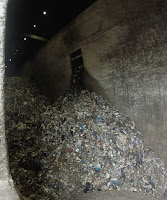 |
| Solid waste to be incinerated |
The last facility we visited was a WTE or waste to energy place than took regular municipal solid waste and also industrial waste and turned it into energy using incineration. What I thought was the most interesting about the plant was how they actually produced enough electricity to power all of the facilities in the area, such as the compost facility and themselves, while still selling the remaining electricity back to the electric company. It was definitely not the cleanest process or the safest especially with all the chemicals that were involved, but it still reduced the amount of waste that went into a landfill. Many landfills are preferred in the USA due to cost, but in Europe there isn't the space for them. This has led the EU to create strict policies and regulations on waste and allowed them to find alternatives to landfilling which the USA should follow in my opinion.
 |
| Control room of WTE facility |
Today was pretty exhausting, and thinking about it, many people wouldn't have enjoyed it too much. For me, it really interesting. I take this as a good sign since I haven't really taken any classes in civil engineering yet. Although it isn't the most glamorous part of the island, it's still very important in order to keep Sardenga beautiful for years to come, like the beach we visited over lunch!



























